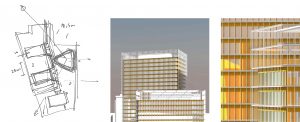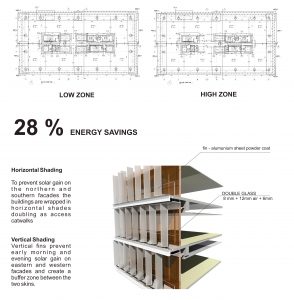Interview by Anton Adianto
Kharis Alfi graduated with a degree in architecture from the National Institute of Science and Technology (ISTN) Jakarta in 2002. He is currently working in PT Pandega Desain Weharima (PDW Architects) and assigned as the senior architect and responsible for BIM implementation program.
His first job for RNN Designworks introduced him to the use of virtual building concepts in the industry. He was assigned as building information modelling (BIM) officer and administrator of roll-out standardisation for Bank Permata in 2004-2005, and assisted PT. PP (Pembangunan Perumahan) in their BIM documentation for the construction of a 50,000-square-meter retail mall in Bandung in 2006. After completing his role in Encona Inti Industri for Chevron Pacific Indonesia in 2006, he formed Biru Laut Design and Build in 2007 and subsequently joined PDW Architects in 2011 where he started the initiative of BIM institute.
Two years ago, Kharis Alfi co-founded the Institute of BIM Indonesia (Institut BIM Indonesia, IBIMI) with several professionals and academicians to promote broader BIM implementation in the industry.
What is the Institute of BIM Indonesia (IBIMI)?
IBIMI is a non-profit BIM development and implementation organisation that is developing an optimal, multi-disciplinary, cross-platform, open-resources and open-collaboration. IBIMI invites all stakeholders to jointly develop and carry out BIM implementation in Indonesia. Our mission is to start and develop BIM standardisation, educate, and share methods and strategies for collective implementation with Indonesia’s architectural, engineering and construction industry, as well as collaborate with the global industry.
 Why did you decide to establish IBIMI?
Why did you decide to establish IBIMI?
The number of BIM users, both individuals and companies, in Indonesia is quite a lot. However, these users have their self-developed standards, with individual BIM systems by their respective software vendors. Since BIM’s emphasis is on the use of information, this methodology approach will be more useful if the information is standardised and open. For this reason, IBIMI was formed to start a discussion on this standard agreement.
Because the challenge is to create human resources capable of operating this methodology, IBIMI also strives to create a standard of competence, not only for deliverables or services, but also for those who operate this system.
How important is BIM to the design and construction industry?
Currently, there are many misconceptions about BIM itself. In fact, BIM is not a new methodology; only its terminology is new. Previously, we know it as a virtual building or virtual design and construction programme, where a building is simulated before it is built. This simulation assists in cost, schedule, sustainability and asset management.
BIM will be beneficial if used extensively in the life cycle of a construction project. One of the benefits is the suppression of cost, schedule and material wastage. This is possible because with the existing simulations, we can make predictions from the beginning of the design stage. Generally, wastages from traditional workflows result in the construction industry becoming a low-productivity industry. Scandinavians claim they are achieving 1 per cent productivity waste with BIM implementation. So yes, BIM is very important for the Indonesian construction industry to compete globally.
Many design processes can also be shortened. Many things can be done off-site, prepared and anticipated beforehand so that on-site work becomes more efficient. Traditionally, when drafting a double-storey residential project, the architect must be accompanied by a draughtsman or two, to draft all architectural drawings, not to mention M&E and structure; using BIM, it is possible for that work to be done by one person only.
With BIM, when we design a project, we also do documentation. In the past, when we changed an architecture drawing in the final stage, we had to change all the adjacent drawings one by one. But with BIM, the changes will be automatically in line with the other parts of the drawings.
Another benefit is client experience. Usually project’s owners see the architecture drawings in the form of 2D floor plans, elevations and sections, which can be difficult to read. With BIM, all can be seen at once. Owners can not only imagine what the project will look like, but can also participate in the coordination and decide right away if there is a design change. By experiencing this workflow, owners will feel involved in the planning and construction process because they can see and feel the process directly.
What challenges does IBIMI face in introducing this technology in Indonesia?
There are several challenges in the implementation of BIM in Indonesia, such as the unavailability of national standards and guidelines, the lack of BIM experts and the low participation of the construction industry. We try to catalyse these issues with integrated programmes; together we work and discuss with professional associations and the Ministry of Public Works to prepare standards and guidelines and collaboration.
Our one-year programme is to reach a common consensus in the form of standardisation. This will be implemented in collaboration with the Ministry of Public Works, especially with Bina Konstruksi, in developing construction services.
How has the design and construction world in Indonesia responded to BIM?
As with other changes, many design and construction companies are reluctant and hesitant to start using BIM methodology. This is natural because we have to get out of workflow habits formed over decades. As early adopters prove its benefits, BIM is growing in penetration in Indonesia. The next wave of new users is more confident about the value of BIM methodology for their businesses.
One challenge is that many people and companies see the cost of having BIM methodology as expenses instead of investment. They see the benefits, but they are reluctant to implement. IBIMI understands, because the BIM implementation does not complete when you buy the software, but it also requires proper infrastructure and skilled technical expertise. Software vendors often introduce the “wow” factors and benefits of their products only, and they do not review the returns on investments for those who are willing to switch. We need to build the industry and ecosystem, so they will sustain. The industry will create their own incentives by using BIM and that is from project efficiency and manpower.
How does BIM relate to education?
When we introduce a new approach in which BIM is a cross-disciplinary open-source system, then the world of education begins to open. At Bandung Institute of Technology (Institut Teknologi Bandung, ITB) and Indonesian Islamic University (Universitas Islam Indonesia, UII), architecture department has collaborated with civil engineering department to create a final project. For example, a civil engineering student can easily use the BIM model from an architecture student’s final project and collaborate in an open BIM environment.
Academics who see that BIM can synergise with many majors will find this technology helpful. BIM’s way of thinking can be infused into the existing curriculum to train future BIM experts with a thorough understanding of the methodology, instead of relying on individual companies to train employees.
What are your aspirations for IBIMI in the near future?
We are projecting IBIMI to be as strong as BIM council in other countries where they lead the implementations and reference, similar to the Green Building Council Indonesia (GBCI) for sustainable buildings. Now GBCI has their discussion on having BIM methodology into one of many considerations for rating points for Green buildings. In near future, we are expecting many more discussion between IBIMI and GBCI.
We need standardisation to be present in model criteria and deliverable. What we want to see is synergy among industry players, such as consultants, professionals, educational institutions and manufacturing, so that BIM methodology can be accepted by many industries and this will surely create many more BIM experts who understand the whole concept of the technology. I believe the future of BIM is growing and will be well received by all parties.

 Malaysia
Malaysia Hong Kong
Hong Kong Singapore
Singapore Tiếng Việt
Tiếng Việt ประเทศไทย
ประเทศไทย














